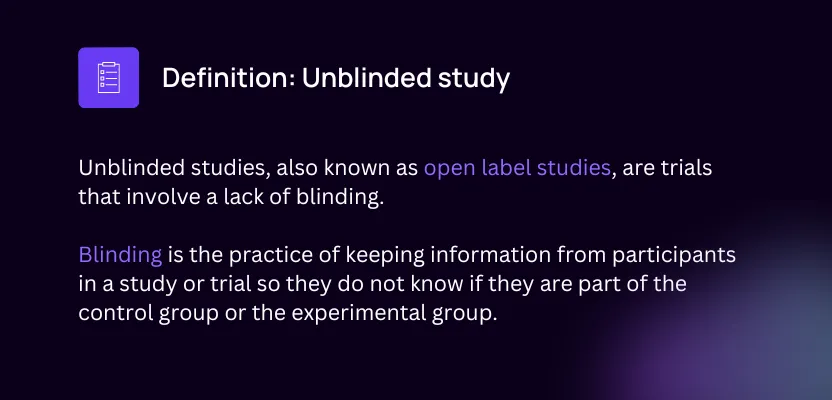Your session is about to expire
Shedding Light on Open-Label: The Role of Unblinded Studies in Clinical Research
Unblinded study definition
Unblinded studies, also known as open label studies, are trials that involve a lack of blinding. Blinding is the practice of keeping information from participants in a study or trial so they do not know if they are part of the control group or the experimental group. In unblinded studies, researchers and participants know which treatments are being compared.

Unblinded study vs. open label study
Unblinded studies are essentially the same as open-label studies; both are clinical research studies in which participants are aware of what treatment they are receiving. Open-label study is the more common terminology.
Other types of blinding: Single blind study and double blind study
An unblinded study differs from a blinded study. In single blind and double blind studies, either participants (single-blind) or both participants and researchers (double blind) are blinded to the treatment assignments. For more information on blinding in research studies, have a look at our comprehensive guide to Clinical Trial Study Design (scroll down to “Factor 4: Blinding”).
Unblinded study example: When would researchers conduct an unblinded or open label study?
One circumstance in which open label studies are particularly appropriate are single-arm trials, or uncontrolled trials, wherein there is no grouping at all. In such cases, it would not be feasible to blind participants since there is only one possible assignment.
Other specific examples of scenarios appropriate for unblinded studies include open-label extension studies, compassionate use studies, dose-escalation/dose-finding studies (phase I or phase II clinical trials), and case series/case studies.[1] Participants can still be randomized in open label studies.
Unblinded study bias and potential risks
In general, for studies involving more than one study group, a lack of blinding presents a risk of introducing significant bias, and thus unblinded studies are usually reserved for cases wherein it would be infeasible or unethical to blind participants.[1] If a study measures entirely objective outcomes (for example, survival), it may also be acceptable to use an unblinded design.
When participants are aware of their assignment or what study treatment they are receiving, their expectations and behaviors can affect outcomes - sometimes significantly. These influences could take the form of:
- the placebo effect (strongly believing that one is or is not experiencing a given effect);
- modified adherence to protocol (for example, stopping taking the study drug because of worries that an unassociated symptom is a side effect of the treatment); or
- the influence of this knowledge on external behavior (for example taking extra care of personal nutrition or exercising more to compensate for not receiving any treatment for their condition).
Furthermore, when analyzing and communicating results from open label or unblinded trials, it’s important to distinguish between real effects that are attributable to the study medication versus subjective patient self-reporting measures, which could be influenced by their knowledge about study treatments and how these relate to positive/negative changes they experienced during participation in the unblinded trial.
Difference between unblinding and unblinded studies

It’s important not to confuse unblinding with the concept of unblinded studies.
Unblinding refers to removing the blind (for patients or researchers) during a blinded trial, either intentionally (planned as per protocol or in an emergency situation such as severe adverse event warranting the revelation of this information). Unblinding can also occur accidentally, where a participant becomes aware of their assignment unintentionally.
On the other hand, an unblinded study or open label study means that no blinding was involved at any point during the trial period.
Conclusion
In this article, we highlighted some key considerations related to understanding and conducting unblinded clinical research trials, including potential advantages and disadvantages associated with this type of design choice. While unblinded studies have particular use cases, as a general rule they are less robust than randomized controlled trials (RCTs).